Related Research Articles

The Bristol Type 156 Beaufighter is a British multi-role aircraft developed during the Second World War by the Bristol Aeroplane Company. It was originally conceived as a heavy fighter variant of the Bristol Beaufort torpedo bomber. The Beaufighter proved to be an effective night fighter, which came into service with the Royal Air Force (RAF) during the Battle of Britain, its large size allowing it to carry heavy armament and early airborne interception radar without major performance penalties.
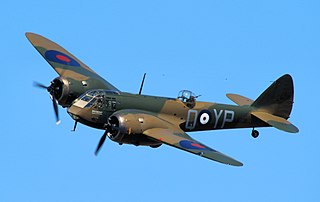
The Bristol Blenheim is a British light bomber aircraft designed and built by the Bristol Aeroplane Company (Bristol) which was used extensively in the first two years of the Second World War, with examples still being used as trainers until the end of the war. Development began with the Type 142, a civil airliner, after a challenge from Lord Rothermere to produce the fastest commercial aircraft in Europe. The Type 142 first flew in April 1935, and the Air Ministry, ordered a modified design as the Type 142M for the Royal Air Force (RAF) as a bomber.

The Bristol Brigand was a British anti-shipping/ground attack/dive bomber aircraft, developed by the Bristol Aeroplane Company as a replacement for the Beaufighter. A total of 147 were built and were used by the Royal Air Force in Malaya during the Malayan Emergency and Kenya until replaced by the de Havilland Hornet in Malaya and the English Electric Canberra jet bomber elsewhere.
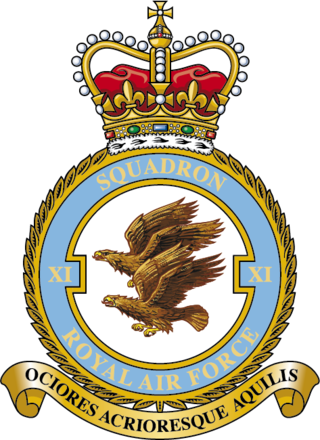
No. 11 or XI Squadron, is "the world's oldest, dedicated fighter unit" and continues the traditions established by the similarly numbered Royal Flying Corps squadron, established in 1915. After a history of equipment with numerous different aircraft types, the squadron most recently operated the Tornado F3 until 2005 when it was disbanded. It was reactivated in 2006 to operate the Typhoon F2, receiving its first aircraft on 9 October 2006.

The Bristol Bulldog is a British Royal Air Force single-seat biplane fighter designed during the 1920s by the Bristol Aeroplane Company. More than 400 Bulldogs were produced for the RAF and overseas customers, and it was one of the most famous aircraft used by the RAF during the inter-war period.

The Bristol Type 171 Sycamore was an early helicopter developed and built by the helicopter division of the Bristol Aeroplane Company. The name refers to the seeds of the sycamore tree, Acer pseudoplatanus, which fall with a rotating motion. It has the distinction of being the first British helicopter to receive a certificate of airworthiness, as well as being the first British-designed helicopter to be introduced by and to serve with the Royal Air Force (RAF).

The Bristol F.2 Fighter is a British First World War two-seat biplane fighter and reconnaissance aircraft developed by Frank Barnwell at the Bristol Aeroplane Company. It is often simply called the Bristol Fighter, "Brisfit" or "Biff".
University Air Squadrons are training units under the command of No. 6 Flying Training School RAF of the Royal Air Force and their main role is to attract students into careers as RAF officers. Primarily its goal is achieved through offering basic flying training, force development and adventure training to undergraduate students at British universities. These units exist to provide a taste of life in the Service and to give experience to their members in preparation for taking up a career as an officer in one of the RAF's many branches.

Number 13 Squadron, also written as XIII Squadron, is a squadron of the Royal Air Force which operate the General Atomics MQ-9A Reaper unmanned aerial vehicle from RAF Waddington since reforming on 26 October 2012. The unit first formed as part of the Royal Flying Corps on 10 January 1915 and went on to fly the Martinsyde G.100, the Royal Aircraft Factory F.E.2, the SPAD VII and SPAD XIII, the Sopwith Dolphin during the First World War. In Second World War it started out operating the Westland Lysander for army cooperation. From late 1942 it used Blenheims in North Africa but in 1943 squadron converted to Ventura for coastal patrols and convoy escort duties. Post war it operated Mosquito before transitioning to the new jet aircraft Gloster Meteor and English Electric Canberra for photoreconnaissance. From 1 January 1990, it operated the Panavia Tornado, initially the GR1A at RAF Honington and later the GR4/4A at RAF Marham where it temporarily disbanded on 13 May 2011.
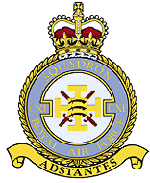
Number 111 (Fighter) Squadron, also known as No. CXI (F) Squadron and nicknamed Treble One, was a squadron of the Royal Air Force. It was formed in 1917 in the Middle East as No. 111 Squadron of the Royal Flying Corps during the reorganisation of the Egyptian Expeditionary Force after General Edmund Allenby took command during the Sinai and Palestine Campaign. The squadron remained in the Middle East after the end of the First World War until 1920 when it was renumbered as No. 14 Squadron.

Filton Airport or Filton Aerodrome was a private airport in Filton and Patchway, within South Gloucestershire, 4 NM north of Bristol, England.
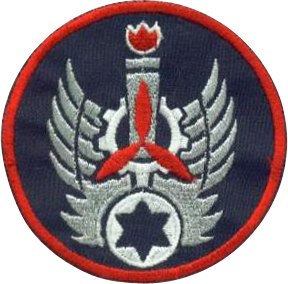
Tel Nof Israeli Air Force Base, also known as Air Force Base 8, is one of three principal airbases of the Israeli Air Force. It is located near Rehovot, Israel.

RAF Horsham St Faith is a former Royal Air Force station near Norwich, Norfolk, England which was operational from 1939 to 1963. It was then developed as Norwich International Airport.

404 Long Range Patrol and Training Squadron is a long range patrol and training squadron in the Royal Canadian Air Force. The squadron was originally No. 404 Squadron of the Royal Canadian Air Force (RCAF) and later the Canadian Forces Air Command.

No. 141 Squadron was a squadron of the British Royal Air Force. It was first formed as part of the Royal Flying Corps in January 1918 as a fighter squadron, serving on home defence duties for the rest of the First World War., before being disbanded in 1920. The Second World War resulted in the squadron being reformed in 1939, serving as a night fighter and night intruder squadron until being disbanded in September 1945. it was reformed again in 1946, flying night fighters until 1958, while from 1959 until 1964 operated surface-to-air missiles.
No. 104 Squadron RAF is a former squadron of the British Royal Air Force.
No. 62 Squadron of the Royal Air Force was originally established as a Royal Flying Corps squadron in 1916 and operated the Bristol F2B fighter in France during the last year of the First World War. After the war the squadron was disbanded and it was re-established in 1937 as part of the buildup of the RAF in the late 1930s. During the Second World War the Squadron was deployed to the Far East, operating the Bristol Blenheim from Singapore and Malaya. In 1942 No. 62 Squadron was re-equipped with the Lockheed Hudson and it moved to Sumatra, then Burma and then India. After the close of World War II the squadron disbanded for the second time. It was briefly re-established from 1946 to 1947 as a Dakota squadron and operated out of Burma and India. It final incarnation was as a Bristol Bloodhound missile unit in the early 1960s.
Lod Air Force Base, also Air Force Base 27, was an Israeli Air Force airfield that was part of the Ben Gurion International Airport, located approximately 7 km (4 mi) north of Lod; 8 km (5 mi) east-southeast of Tel Aviv.
No. 139 (Jamaica) Squadron RAF was a Royal Air Force Squadron that was fighter unit in World War I and a bomber unit from World War II until the 1960s.
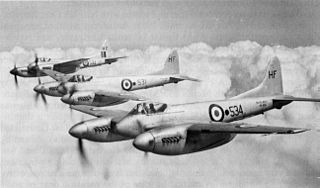
728 Naval Air Squadron was a Naval Air Squadron of the Royal Navy's Fleet Air Arm. It was formed in 1943 as a Fleet Requirement Unit, operating from airfields around the Mediterranean before settling for most of its existence in Malta.
References
- ↑ "Bristol University Air Squadron". Royal Air Force. Retrieved 31 May 2020.